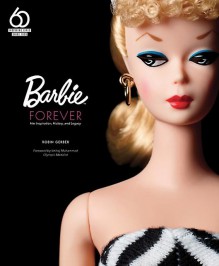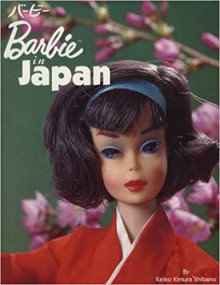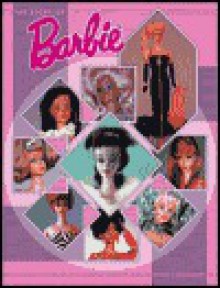
First of all, let me just say that there is no real fault to the main text of this book. Gerber approaches the story of the Barbie doll from her background of writing the biography of Ruth Handler, Barbie's creator and a pioneering woman in her own right, even without considering her most famous invention. The problem is that this seemed like a rushed job and there wasn't any passion or attention to detail in the creation of the book.
The narrative here is about how inspirational Barbie is as a play doll and as an icon to many generations of women and men. Things only broke down when I noticed factual errors and omissions in many of the splendid photographs included in the book.
This is a sanctioned, official Mattel product put out for the 60th Anniversary of their flagship toy, how is there even one basic error, let alone enough that I stopped keeping count? The errors may seem unimportant, but a year or two difference in a date means a lot in the collecting world, especially when Gerber cites many of the better researched Barbie books in her bibliography. There are simple facts of production years and availability for outfits, dolls and accessories that are made clear as day in those other books, but are clouded here. Other photos show a potentially fascinating interior look at a design office, groups of personnel, and retail or convention displays - with only the slimmest of notations. One instance shows a full retail display of the Barbie clothing line for children that was scrapped in the early '60s without ever hitting stores - the caption describes it merely as a woman looking at a display of Barbie merchandise.
The book also follows the convention where the text and the photos don't pair up. The photos were obviously collected and laid out by a completely different individual and little effort was made past the opening segment of the book to pair the text with relevant photographs. Many of the photos are amazing, have not been widely available before, and deserved more attention. I did not need to hear more from Billyboy,
Barbie is inspirational and a lot of effort has been made by the Mattel corporation in recent years to create an inclusive array of dolls that are the best quality for the price-point and reflect all children. I'm saddened, though, that there didn't seem to be anyone attached to this book project with any real knowledge or passion of the history of the brand.
As Charlie Brown would say, I just can't stand it! For your time here are some shots of some of the dolls and outfits Jon and I gave each other this year:

A #6 Blonde Ponytail in 1960's 'Busy Gal', the portfolio under her arm contains two fashion sketches. The outfit is complete and all original except for the Navy (almost black) shoes, which are scarce.
On the right is a #4 Brunette Ponytail wearing 1959's 'Plantation Belle'. The pink shoes (not pictured) have holes drilled in the bottom to accommodate the original doll stand.

Finally! A Free Moving Curtis and a Christie I can play with! Curtis (who has the same face mold as Brad, but has a ball-jointed waist so he can swing a golf club) wears 1970's 'Big Business' with the wrong tie.
Seated, because her fabulous brocade pantsuit won't allow a stand, is a stunning Twist 'n Turn Christie in 1969's 'Firelights'. She has great face paint - I want to try to turn her hair back to black, but Jon won't let me, since its otherwise in perfect shape.
On the right is our Twist 'n Turn Stacey in 1972's 'All American Girl'.

Finally, on the left I have a #1 Ken in the 1964 version of 'Skin Diver', which included the hooded sweatshirt. We haven't redone the elastic on the facemask yet.
In the middle, hovering due to too-tall stands, are Skipper's friends from 1965 Ricky and Skooter. Ricky has his original swimsuit and Skooter wears 1965's 'Land and Sea' and has her original hair ribbons.
On the right is another #4 Barbie, this time a blonde with her hair trimmed and arranged loose, in 1959's 'Resort Set', her cork wedge heels have holes drilled in the bottom, too.

 Log in with Facebook
Log in with Facebook 















